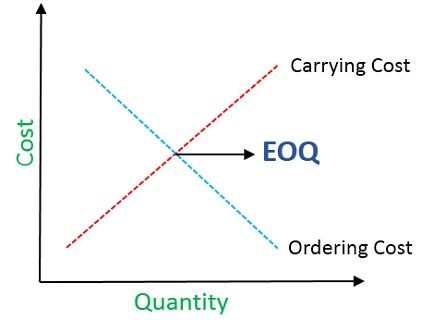Definition: Economic Order Quantity, popularly known as EOQ is the standard order quantity of materials which a firm should order at a given point in time with an aim of minimizing the annual inventory costs like holding/carrying cost, and order cost.
It is a production scheduling model which was coined by Ford W. Harris in the year 1913 and has been updated with the passage of time.
Ordering Cost
Ordering cost refers to the fixed cost involved in the preparation and processing of the supplier’s order irrespective of the lot size, such as cost of inviting quotations, cost of placing an order, inspection cost, documentation, transportation cost, etc.
Holding Cost
The total cost of holding, i.e. storing and maintaining a specific lot of the inventory, is called holding cost or carrying cost. It embraces warehouse expenses like rent, utilities, salaries, property taxes, etc. opportunity cost, and inventory cost associated with leakage, obsolescence and insurance.
Along with that, the cost of funds invested in inventories is also covered in it.
Formula of EOQ
The formula used for ascertaining the economic order quantity is derived by the renowned mathematician “Wilson”. The formula is given as under:
Where,
- A = Annual Requirement (demand) for raw material for the year
- O = Cost of placing per order for purchase
- C = Cost of carrying average inventory per unit, annually.
EOQ formula is used to decide the optimal order size, i.e. the number of units of products to be added to the inventory with each order at one time.
Why EOQ?
It is a well-known fact that the cost of ordering the inventory decreases with the increase in volume, because of economies of scale, but due to the increase in the size of the inventory, the carrying cost increases.
At EOQ both ordering cost and carrying cost are minimum. It is also called an optimum lot size.
It is mainly used in the field of production, operations, logistics and supply chain management, to ascertain the volume (how much) and frequency (how often) of the orders, needed so as to fulfil the specific level of demand.
EOQ is helpful in determining the ideal order size, so as to maintain a supply chain which is cost-effective. In this, a fixed quantity is ordered whenever the inventory level is down to a certain reorder point. It helps in the calculation of reorder point and reorder quantity, to facilitate immediate refilling of the inventory to avoid shortage.
Assumptions of EOQ
There are certain assumptions with respect to EOQ, which are discussed as under:
- Material cost per unit, Ordering cost per order and holding cost per unit (on annual basis) is known and fixed.
- Potential raw materials or inputs usage in units is known.
- Quantity of material ordered is received instantly, meaning that there is no lead time.
- The new batch of raw materials is delivered in full
- The inventory decreases at a fixed rate until it becomes nil.
EOQ calculation determines exactly when an order has to be placed and the quantity which is to be ordered, for uninterrupted production and minimum total cost of inventory.


Leave a Reply